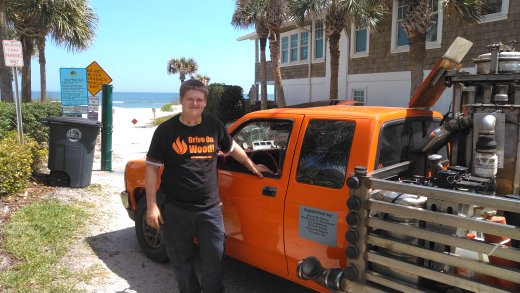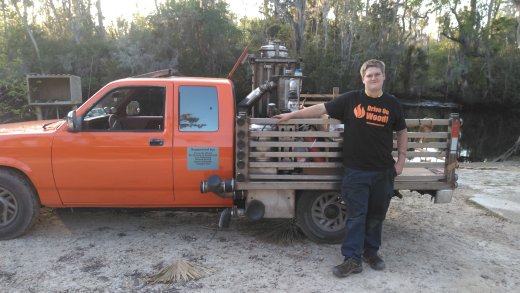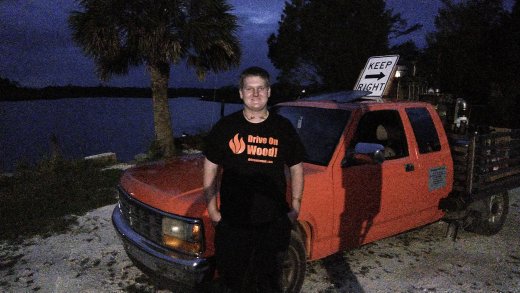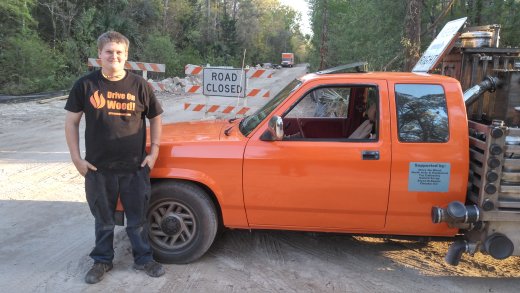I am at least going to empty the gasifier sometime soon and inspect it. I might even remove it and disassemble it but the silicone to do that gets costly.
I like too buy 11 at 53.$ at jrproductsinc.com at about under 5 bucks a tube free shipping over 50$The red devil brand.
No knock on wood
Jakob North feeds a bag of wood scraps into a homemade device that powers his pickup truck. [Matt Soergel/The Times-Union]
HIDE CAPTION
Jakob North, 16, drove to Atlantic Beach on Saturday from his home in Alabama, taking his pickup truck, which runs on a homemade “gasifier” powered by wood scraps. He hopes to eventually cross the nation in the truck when the pandemic comes to an end. [Matt Soergel/The Times-Union]
HIDE CAPTION
Jakob North feeds a bag of wood scraps into a homemade device that powers his pickup truck. [Matt Soergel/The Times-Union]
HIDE CAPTION
Jakob North, 16, drove to Atlantic Beach on Saturday from his home in Alabama, taking his pickup truck, which runs on a homemade “gasifier” powered by wood scraps. He hopes to eventually cross the nation in the truck when the pandemic comes to an end. [Matt Soergel/The Times-Union]
HIDE CAPTION
Jakob North feeds a bag of wood scraps into a homemade device that powers his pickup truck. [Matt Soergel/The Times-Union]
Next
Posted Mar 21, 2020 at 10:31 PM
ATLANTIC BEACH – At 2:30 a.m. Saturday, 16-year-old Jakob North got into his pickup truck at his home in Randolph County, Ala., fired up the engine and headed out into a world of lighter traffic and the coronavirus pandemic.
His goal: the Atlantic Ocean.
The teenager’s transport: a 1993 Dodge Dakota pickup, bright orange, which looked, appropriately enough, like something you might see in a post-apocalpytic movie. It has a big stainless steel contraption he built himself that takes up much of the truck bed, along with bags of wood scraps that power that device.
It’s called a gasifier, and it converts chunks of dried wood (leftovers from a cabinetry shop in this case) into the fuel that drives his truck.
North – the latest in a long line of mechanics in his family – wants to demonstrate that this gasifier can be adapted to places in the developing world where gas is expensive or hard to find.
To do that, he planned to drive from Alabama to the Atlantic Ocean, then hit the Gulf of Mexico, the California coast and the Canadian border. In all, he would travel some 8,000 miles before his 17th birthday.
Then came the coronavirus and lockdowns and social distancing, ending that plan for now.
But Jakob and his father Billy figured they could sneak in the first part of trip before things got too bad, avoiding human contact and hotel stays. So they headed Saturday from their 10 acres in Alabama to get to Atlantic Beach, cruising at 73 mph and burning wood the whole way.
In Jacksonville traffic, their eye-catching Mad Max vehicle got plenty of questions at lights: Does it run on wood? Did you build it?
At the beach, they stopped for an interview – no handshakes, six feet of social distancing for everyone – and to use excess heat from the gasifier to heat a skillet of bacon and hot dogs from a Piggly Wiggly, with all the condiments and Wonder Bread rolls (the only ones they could find).
They got some curious looks from joggers and walkers as they did it. “There’s probably an ordinance in this town against cooking in the street during a pandemic,” Billy North joked.
Jakob’s parents, who are Anabaptists, run an organization called ADAPTech, which trains missionaries and development workers to help people in poor countries. Often they use whatever’s locally available to improve the quality of peoples’ lives.
They’re now working in the Democratic Republic of Congo, helping a community of war refugees.
“I’ve been around experts all my life who make do with what they have, who make weird things,” Jakob said.
At 12, he saw a lawnmower that had been converted to run on charcoal, using a popcorn filter. He went home and built himself one. He then adapted a small tractor to run on charcoal and water. At 15, he converted a pickup truck to run on wood, using his first gasifier, and drove it to a conference in Indiana.
It was rear-ended and totaled after he got home, so he took that gasifier and put it another truck. After that, he built another gasifier of his own design, and put it in the orange Dodge he drives now, which has been on the road 10 years longer than he’s been alive.
“He’s in the seventh or eighth generation of mechanics,” Billy said. “It’s kind of in his DNA, I believe.”
The hottest part of the gasifier runs at about 1600 degrees, though there’s a lot of insulation in the device and cooling rails that run down the length of the truck bed. Jakob’s new design allows the truck to go much faster than the older one, which topped at at around 45 mph.
It still has a gas engine that helps start the vehicle and can take over if something goes wrong with the wood engine, though that’s just a precaution: Jakob is handy, and once fixed a leak in the gasifier by using a beer can he found on the side of the road.
The Norths, father and son, explained the benefits of the gasifier system, saying the wood gas is more efficient than petroleum and uses material that would often otherwise end up in a landfill. All the carbon that’s released is the same as if the wood had naturally decayed, they said.
Plus it never gets old driving past gas stations without stopping, Billy said.
In Atlantic Beach, Jakob, wearing protective headgear, poured several bags of wood chunks into the fiery hot gasifier. Now they were ready to journey to their next destination: the Gulf of Mexico somewhere in the Florida panhandle, before heading up to Alabama.
But first, they had to prepare for dinner, which they did by putting foil-wrapped burritos onto the engine block under the hood.
“When we get the Gulf,” Billy said, “they’ll be ready to eat.”
https://www.starfl.com/news/20200325/psj-trip-disrupted-by-covid-19
Port St Joe Florida was supposed to be the Gulf of Mexico stop, but we had to change plans. The reporter there decided to write the story anyway.
PSJ trip disrupted by COVID-19PSJ trip disrupted by COVID-19
MOST POPULAR
Never Miss A Story
Subscribe to The Star, Port St. Joe
OUR PICKS
UPCOMING EVENTS
By Tim Croft
@PSJ_Star
Posted Mar 25, 2020 at 12:01 AM
Updated Mar 25, 2020 at 11:01 PM
Jakob North had to improvise as the coronavirus raced across much of the country.
North had long-planned WoodGas 2020, a personal trip from sea to shining sea, Gulf of Mexico to the Canadian border in his truck.
A truck, which Jakob, just 16, built from the ground up.
A truck, by the by, that is powered primarily by wood.
If completed, and Jakob’s western swing is scheduled to begin in May though it takes him to the state of Washington, North’s trip would be the longest ever taken in a wood-burning vehicle.
He hopes to accomplish the trip before his 17th birthday but even if his trip extends past that date Jakob would be the youngest person, and have the longest cross-country trip, in a wood-burning vehicle.
In late March, after a bout with, ironically, the flu, North set off from his home in Randolph, AL for the southern swing of his trip.
His original plan was to drive to Port St. Joe and see the Gulf of Mexico from the county’s sandy shores; Jakob already had beach access points and a spot for photos picked out.
COVID-19 brought other ideas.
So, Jakob and his father, Billy North, Jr., improvised.
The route was altered to allow for a shorter driving distance to the Gulf without any overnight stays and food was carried from home to restrict any contact with humans, though that contact is part of WoodGas 2020.
But, so many roads, state parks and beaches were closed once Jakob reached the coast that he actually had trouble even reaching the Gulf of Mexico.
But he did and is on his way back to his home base in Alabama.
As of Tuesday, he was at the Alabama state line, four hours from Randolph, and had traveled 690 miles.
Over his first 580 miles, Jakob used 681 pounds of wood and just a quart of gasoline.
Ultimately, the planned trip will cover nearly 8,000 miles and take Jakob to 24 states, Billy said, with Jakob in a truck hauling a small trailer for his fuel wood.
The trip has two primary purposes: to prove the technology and to promote it to agencies working with developing nations to assist the poor.
The North family operates ADAPTech (Advancing Development with Applied Practical Technology, a training and development organization focused on aiding the poor of the world meet basic human needs.
The gasification technology used in the wood-burning vehicle could be implemented to create a local, sustainable energy source in developing countries where petroleum is impractical, Billy said.
The energy has a range of uses in industries from transportation to food canneries that require large amounts of energy, Billy said.
Jakob, who is dual-enrolled student, is already the youngest person (15) to transverse the U.S. in a wood-powered vehicle, again made by Jakob, when he drove from Randolph to the Great Lakes and back.
That truck was totaled by another vehicle upon his return to Randolph so Jakob built a second as a present to himself for his 16th birthday.
He built a third, started it in November and finished it last month, for his trip across the country.
Along the way Jakob designed a new wood gasifier of stainless steel to withstand higher heats.
The truck is able to sustain highway speeds of 70 mph and higher, Billy said, adding that Jakob needs about .75 to 1.3 pounds of wood per mile.
Billy said most understand that most gas burned in automobiles contains some ethanol, derives mostly from corn.
In a Cliff Notes version, with a wood gasifier the driver makes fuel as he needs it.
Wood must be cut a uniform size and dried as much as possible and is added via a “hopper”, typically a drum or container directly above the “reduction zone” or “fire tube.”
The fire tube is an insulated area of intense heat created by a charcoal fire; temperatures in that area can reach over 1,600 degrees Fahrenheit, Billy said.
This intense heat roasts the wood above the fire tube in order to turn it into a rich smoke that is sucked, by the engine, through the hot charcoal to reduce it into smaller, safer, more combustible molecules, or Wood Gas.
Further, some of the water in the mixture is “cracked” into oxygen gas and hydrogen gas by the extreme heat. The remaining water drains into a holding tank for later disposal.
After the gas is made it is cooled, cleaned, and piped to the engine where it is mixed with air and sent into the engine to be burned.
Simple valves controlled from the driver’s compartment are used to make necessary adjustments to the mixture of air and gas and to the engine timing.
According to Billy, wood gas is 97 percent more efficient that gasoline, any exhaust is cleaner than gas and does not add carbon to the atmosphere.
Jakob carried the wood he needed to hit the coast this past week, but will need to pick up wood along other stretches of his trip.
Billy said friends were cutting and drying wood from Nebraska to Colorado to California to Washington.



Thanks Jakob and Billy !!
Great write up 
Haha! Thank you guys!
A big smile (that required a lemon to straighten out) was on my face reading that 
Very impressed Jakob.
This sounds familiar. It must be my lawn tractor that I took to Argos in 2017. I think Jakob put more miles on that tractor that weekend than I did.
Great write up, sure put a smile on me.
Don, have you added wheelie bars to that thing yet?
Andy, I wondered who would bring that subject up. 
Fantastic Jakob! I hope you can finish your trip this summer and I hope we will be a stop for you.
A true joy to see your accomplishments.
I bagged up your chunks the other day, as the greenhouse is going to be pressed into action soon. I was hoping to spend more time working on projects this year, but growing vegetables seems like it is going to be a better use of my time. I think I underestimated how much drying I would get for those chunks - it seems that they are somewhere in the 8-10% moisture range. I put them in sand bags, which weigh about 15lbs each. only filled 56 of them, so figure 840lbs of very dry wood awaits you here.

They are now moved to long-term storage, and can sit there for as long as needed. If you dont come get them within a few years though, I will start thinking about building a woodgas truck of my own! Hopefully things will be looking up by summer, though, and you will be able to make your epic trip.
Dude, now I’m envious of your wood shed. LOL. Too many tornadoes around here though. I can’t have something like that. 
Jakob finally got around to cleaning out his truck after the southern part of the big trip. Who knows if the rest of it will be possible or when.
But I snapped a shot of him when he got home from cleaning out the system after the first 2400 miles on the build. I’ll let him tell you what he found.
Sounds Great I plan to be there sooner of later we will see how scheduling goes.
I have a little to report on the trip. I don’t see this thing happening till spring. I went ahead and hauled some wood out to Wichita. My uncle lives out there so I have a place to store it It will be one of my stops on my trip out west.
Hey, you got unlucky timing for a cross-country adventure this summer, but thats life. The adventure will still be there, waiting, when the time is right. Use the extra time to log some more miles on wood. When you do finally hit the open road, I am convinced you will not only cross the nation on wood, but you will make it look easy to boot!
No worries Jacob. There is still 1500lb of chunks here for you.
Rindert

